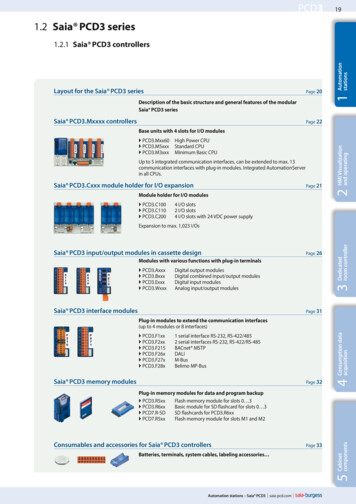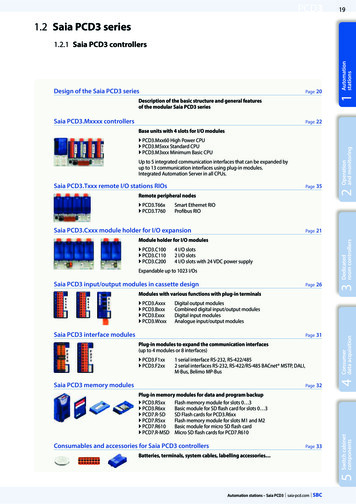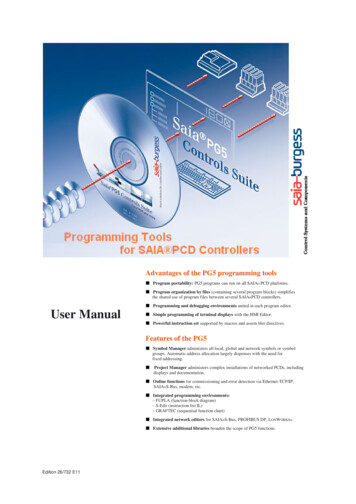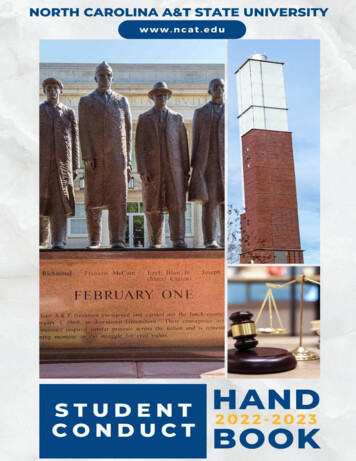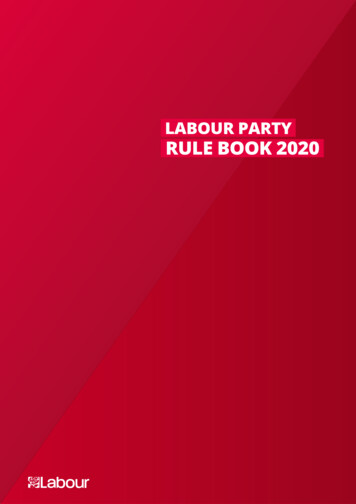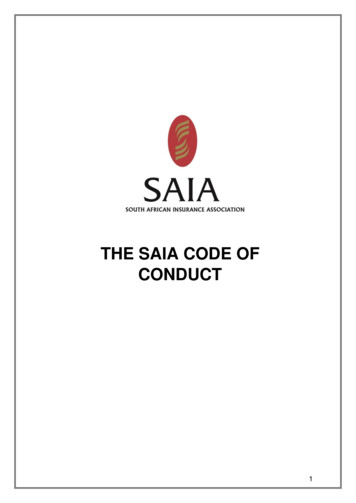
Transcription
THE SAIA CODE OFCONDUCT1
IndexTHE SAIA CODE OF CONDUCT . 11.FOREWORD AND INTRODUCTION . 42.THE PURPOSE OF THE CODE . 63.BENEFITS OF AN INDUSTRY CODE OF CONDUCT . 74.THE OBJECTIVES OF THIS CODE . 85.DEFINITIONS . 96.APPLICATION OF THIS CODE . 107.TRANSITIONAL ARRANGEMENTS . 118.GENERAL MEMBER RESPONSIBILITIES . 129.INCLUSIVE GROWTH AND TRANSFORMATION. 1410.FINANCIAL INCLUSION - CONSUMER EDUCATION AND ACCESS PRODUCTS . 1711.COMMUNICATION WITH CURRENT AND POTENTIAL POLICYHOLDERS . 1912.ADVERTISING, MARKETING AND SOLICITING BUSINESS. 2013.DEALING WITH POTENTIAL POLICYHOLDERS AT UNDERWRITING STAGE . 2114.DEALING WITH POLICYHOLDERS AT CLAIMS STAGE . 2515.DEALING WITH THIRD-PARTY CLAIMS. 3016.DEALING WITH REPAIRS AND WORKMANSHIP . 3517.FRAUD AND DISHONEST CONDUCT . 3618.MEMBERS’ EMPLOYEES AND AUTHORISED AGENTS . 3719.COMPLAINTS . 3820.MONITORING COMPLIANCE WITH THIS CODE . 4821.REVIEW OF THIS CODE . 49ANNEXURE 1 - THE CODE OF MOTOR SALVAGE . .45.55.65.7THE PURPOSE OF THE CODE . 51ACRONYMS AND DEFINITIONS . 52ACRONYMS . 52DEFINITIONS AND EXPLANATIONS . 53SALVAGE CODES . 54CODE 1 – NEW . 54CODE 2 – USED . 55CODE 3 – BUILT-UP . 57CODE 3A – SPARE PARTS ONLY . 59CODE 4 – PERMANENTLY DEMOLISHED . 62STOLEN AND RECOVERED VEHICLES . 66DETERMINING THE CODE OF A STOLEN AND RECOVERED VEHICLE. 66LEGISLATION AND NATIS REQUIREMENTS . 67FURTHER REQUIREMENTS . 68INTERNAL PROCESSES . 68INSURANCE COMPANIES . 68INSURERS AND ACCIDENT DAMAGED MOTOR VEHICLES . 70STOLEN MOTOR VEHICLES . 71INSURERS AND CONTRACTORS . 71UNDERWRITING STAGE . 72CLAIMS STAGE . 73REPUDIATIONS . 732
1213THIRD PARTY SALVAGE . 74INSURERS CONTROL/PROCESS OVER SALVAGE RECORDS . 74DOCUMENTS INCLUDE:. 74VEHICLE SALVAGE DATABASE . 75INSURERS AND POLICYHOLDER . 75INSURANCE COMPANY ELECTS NOT TO REPAIR A VEHICLE . 75DISPOSAL OF SALVAGE TO POLICYHOLDER . 76INTERNAL PROCESSES WHEN SELLING A VEHICLE. 76INSURERS AND TITLE HOLDERS . 77REGISTRATION PROCEDURES. 77STATUS CODING. 78PROCEDURE BETWEEN BANKS AND INSURERS . 78INSURERS AND SALVAGE AGENTS . 78PROTOCOLS OF RESPONSIBLE SALVAGE MANAGEMENT . 78REGISTRATION AND DEREGISTRATION PROCESS . 79SAFEGUARDING. 79PROCESS OF AUDITING SYSTEM . 79STOLEN DOCUMENTATION . 80TRAINING AND AWARENESS. 80ENFORCEMENT . 80CONCLUSION . 81SIGNATORIES . 8122.ANNEXURE A – DEFACED DEREGISTRATION DOCUMENT . 8123.ANNEXURE B – EXAMPLE FORFEITURE LETTER . 8224.ANNEXURE C – PRO FORMA LETTERS . 843
1. FOREWORD AND INTRODUCTIONThe South African Insurance Association (“SAIA”) is the representative body of thenon-life insurance industry in South Africa, through its members representingapproximately ninety percent of the industry in terms of premium income, at alllevels and with all stakeholders.SAIA and its Members are actively committed to a growing and sustainable non-lifeinsurance industry which is resilient, contributes positively to the economy, inspiresconfidence in stakeholders and offers products and services that add real value tothe market.This revised version of the SAIA Code of Conduct (the Code) was launched on 3September 2020.The purpose of the Code is to promote ethical standards and good businesspractices in the non-life insurance industry and to give an indication to its Membersof the guidelines to be followed to achieve these standards.The Code has been enhanced and updated to ensure its continued relevance andthat of its objectives in the changing non-life insurance business and regulatorylandscape.The revised Code focuses more on principles and standards rather than rules. TheSAIA Board is of the view that this focus will position the outcomes envisaged forPolicyholders with more clarity and enable SAIA Members to use the standards asguidelines for achieving the desired outcomes.4
Included in this Code is a section on recommendations for Member participation inachieving the non-life insurance industry’s transformation objectives. This reflectsour industry commitment towards accelerated and meaningful transformation of ourindustry, contributing to an inclusive economy.SAIA is tasked with the duty to monitor its Members’ compliance with the Code andto exercise certain powers as part of its role to encourage, monitor and report oncompliance with the Code.SAIA recognises the roles played by different stakeholders in the non-life insuranceindustry and how each contributes to the sustainability of our industry. Accordingly,this Code encourages Members to require its agents and service providers to adoptapplicable aspects of the Code.The Code is a living document, and SAIA with input from its Members, will continueto improve the document so that it accommodates the changing landscape andremains relevant.5
2. THE PURPOSE OF THE CODE2.1The Code is not intended to be legally binding. It is rather intended to setout principles and standards of desired conduct for all SAIA Members.2.1.1The purpose of this Code is to:2.1.1.1Promote ethical standards and good business practicesin the non-life insurance industry.2.1.1.2Give clear and specific conduct guidelines to befollowed by Members that provide non-life insuranceproducts to current and potential Policyholders.2.1.1.3Promote an awareness and understanding of the nonlife insurance industry to all stakeholders.6
3. BENEFITS OF AN INDUSTRY CODE OF CONDUCT3.1An effective code of conduct is important to:3.1.1Instil confidence in current and potential Policyholders in theinsurance industry and the broader financial sector.3.1.2Encourage self-imposed ethical and professional businessstandards and practices by its Members.3.1.3Assist in the elimination of improper practices.3.1.4Protect current and potential Policyholders by facilitating the ongoing development of appropriate products and services.3.1.5Codify best practice which sets the benchmark for proper conductby Members.7
4. THE OBJECTIVES OF THIS CODE4.1The objectives of this Code are to:4.1.1Commit Members to high standards of conduct.4.1.2Enhance the image and reputation of, and promote trust andconfidence in, the non-life insurance industry.4.1.3Promote sound, informed, professional and ethical relationshipsbetween Members, and between Members and current andpotential Policyholders.4.1.4Provide for the fair and effective resolution of complaints anddisputes between Members and Policyholders in relation tocompliance with the Code.4.1.5Contribute towards a sustainable non-life insurance industry.4.1.6Promote transformation and financial inclusion in the non-lifeinsurance industry.4.2These objectives must be pursued with due regard to current legislationand regulation, acknowledging that an insurance policy is a contract basedon good faith.8
5. DEFINITIONS5.1“ARB” means the Advertising Regulatory Board.5.2“Authorised Agent” means a person authorised by a Member to providefinancial products and services on behalf of the Member (Example: financialintermediary).5.3“Co-Insurance Arrangement” means an insurance arrangement wherebytwo or more insurers share the same risk.5.4“ICB” means the Insurance Crime Bureau.5.5“Member” means a non-life insurer that is a member of SAIA.5.6“Policyholder” means a person who holds a non-life insurance policy or aperson to whom the benefit of a non-life insurance policy extends.5.7“Reinsurer” means a Member of SAIA that conducts reinsurancebusiness.5.8“SAIA” means the South African Insurance Association NPC, therepresentative industry association for the non-life insurance industry.5.9“Service Provider” means a person authorised by a Member to provide aspecific service. Example, an investigator, a motor body repairer, etc.9
6. APPLICATION OF THIS CODE6.1This Code applies to all SAIA Members.6.2The Code applies to reinsurers and Sasria, where applicable. Where nodirect relationship exists between reinsurers/Sasria and their clients, thespecific clauses in this Code that relate directly to the business relationshipbetween Members and their clients do not apply.6.3Where there is a conflict or inconsistency between this Code and anyapplicable law, the law always prevails. Members must inform SAIAimmediately they become aware of any conflict or inconsistency betweenany legislation and this Code.6.4Under a Co-Insurance Arrangement where one or more insurers in thatarrangement is not a SAIA Member, this Code will apply to the extent thatis practicable having due regard to the nature of the co-insurancearrangement.6.5Where this Code imposes an obligation on Members in addition toobligations under any law, the Member must comply with this Code exceptwhere doing so could lead to a breach of the law concerned.10
7. TRANSITIONAL ARRANGEMENTS7.1Members must formally adopt this Code for compliance within their owncompanies within six months from the date this Code takes effect.7.2A Member may submit a request for an extension to comply with the Codeand SAIA will consider the request for an extension based on the meritspresented in the request.11
8. GENERAL MEMBER RESPONSIBILITIES8.1A Member must:8.1.1Comply with the Code and implement procedures and systems toensure compliance.8.1.2Comply with all applicable laws and regulation.8.1.3Hold and maintain all licences, registrations and approvals requiredby law.8.1.4Conduct its business in an honest, fair and transparent manner.8.1.5Ensure that it has the necessary expertise, skills and infrastructureto conduct its business.8.1.6Train its employees on the provisions of this Code.8.1.7Take reasonable steps to inform its Authorised Agents and ServiceProviders of and ensure that they adopt applicable elements of thisCode.8.1.8Implement procedures to ensure that Authorised Agents andService Providers inform current and potential Policyholders of theidentity of the Member for whom they are acting and the servicethey have been instructed to provide.8.1.9Create awareness of its SAIA Membership and its commitment tothis Code.8.1.10 Monitor and assess its compliance with this Code and rectify noncompliance as soon as possible.8.1.11 Report compliance with this Code to SAIA as required from time totime.8.1.12 Cooperate with SAIA and/or the SAIA Code of Conduct ComplaintsCommittee when investigating any alleged non-compliance with theCode, and / or complaints.12
8.1.13 Accept the decisions and/or sanctions of SAIA, the ComplaintsCommittee, and/or the appointed person in the case of appeals.8.1.14 Actively commit to the realisation of transformation in and financialinclusion for the non-life insurance industry.8.1.15 Actively support SAIA’s consumer education programme inaddition to their own consumer education programmes.8.1.16 Comply with the SAIA Code of Motor Salvage as contained in thisCode, if it is applicable to the Member’s business.8.1.17 Preserve the confidentiality of Policyholder information. Suchinformation must only be disclosed as required or permitted by law,as approved by the Policyholder, where it is in the public interest orfor crime combating purposes, as requested by SAIA or theRegulators.13
9. INCLUSIVE GROWTH AND TRANSFORMATIONPrincipleAs the representative of its member non-life insurers, SAIA is committed to thetransformation of the South African economy and believes that accelerated growthis best achieved in an economy conducive of inclusive growth. To achieve this, SAIAhas adopted a proactive approach by developing and adopting an industrytransformation strategy. Industry priorities are identified and approved by the SAIABoard and subsequently, serve as a guide for member alignment with owntransformation objectives.Standards9.1To deliver on transformation objectives for the non-life insurance industry,Members shall:9.1.1Take accountability by driving transformation, by:9.1.1.1 Adopting the Financial Sector Code (FSC) as acompulsory reporting framework for the non-life insuranceindustry participants.9.1.1.2 Adopting the industry transformation strategy set by SAIA,as a guideline when developing member transformationstrategies and aligning opportunities with the industryobjectives where appropriate.9.1.1.3 tion data by improving member internal datacollecting and storing for the purpose of reporting to SAIAand the Financial Sector Transformation Council (FSTC).9.1.1.4 Adopting and adhering to the SAIA transformationreporting requirements as approved by the SAIA Board.9.1.1.5 Collating and submitting the required annual verified14
transformation data to SAIA and the FSTC.9.1.1.6 Collating and submitting periodic transformation data toSAIA on a regular or ad-hoc basis as may be required forthe purpose of measuring, monitoring and reporting on theindustry transformation progress. The frequency of thesubmissions will be determined on an ad-hoc basis andcommunicated through SAIA MD Circulars.9.1.1.7 Collaborating and participating in industry initiatives bycontributing to the required financial and non-financialresources where tationatallManagement and Control sub-elements, by:9.1.2.1Identifying opportunities and implementing strategies toadvance transformation of member Board and executivemanagement teams.9.1.2.2Aligning internal employment equity strategies in line withthe FSC targets, including improvement of representationof African and Black women in totality at all levels ofmanagement.9.1.2.3Aligning skills development strategies to respond toindustry skills gaps and in support of the FSC’sManagement and Control element objectives.9.1.2.4Participating in industry bodies regarding increasing thenumber of Black professionals in the relevant skill sets.9.1.2.5Identifying opportunities to participate in Governmentinitiatives aimed at advancing skills development,15
particularly youth such as the Youth Employment Service(YES) Programme and the funding of tertiary education.9.1.3Support industry commitment to drive transformation of preferentialprocurement by:9.1.3.1Increasing spend with Broad Based Black EconomicEmpowerment (BBBEE) compliant suppliers and in ation objectives i.e.; support of Black motor andproperty claims service providers.9.1.3.2Identifying opportunities and supporting industry projectsto transform the industry value chain.9.1.3.3Identifying opportunities to maximise supplier value byaligning procurement strategy with Enterprise andSupplier Development (ESD) strategy and in line with theindustry transformation objectives where appropriate.9.1.3.4Participating in industry approved ESD projects, byproviding the required financial and non-financial support,where appropriate.9.1.4Support and participate in the sector / industry financial inclusionprojects, and in line with the recommendations as contained inClause 10 below, where appropriate.16
10.FINANCIAL INCLUSION - CONSUMER EDUCATION ANDACCESS PRODUCTS10.1Financial inclusion serves as a critical component in promoting economicgrowth and sustainability of the financial sector, as the majority of previouslydisadvantaged individuals are still involuntarily excluded from accessingsome of the products and services within the financial sector, negativelyimpacting the quality of life of an average South African.10.2Financial inclusion can be achieved through participating in ConsumerEducation initiatives, which promote consumer knowledge of the financialsector and its products; and developing appropriate access products for thelow-income consumer market segment.10.3Members are therefore encouraged to promote and participate inConsumer Education initiatives and in line with the requirements of the FSCby:10.3.1 Annually contributing a minimum of 50% of 0.4% of the Net Profitafter Tax Consumer Education FSC target, to the SAIA ConsumerEducation Fund.10.3.2 Carrying out Member initiatives with the balance of MemberConsumer Education contributions to the FSC targets, and in linewith the industry Financial Inclusion objectives where possible.10.3.3 Collaborate within the industry or the sector in support of increasedreach and / or impact by Consumer Education initiatives whereappropriate.10.3.4 Consumer Education Guidance Notes are available from the FSTCwebsite rs are also encouraged to promote Financial Inclusion bydeveloping appropriate access products for the targeted consumer marketsegment and in line with the FSC requirements, where appropriate. Access17
Standards Guidance Notes are available on the FSTC website(https://fstc.org.za/guidance-notes.php).18
11.COMMUNICATION WITH CURRENT AND POTENTIALPOLICYHOLDERSPrincipleMembers must communicate effectively with current and potential Policyholdersthroughout the insurance contract lifecycle, as effective communication enablesPolicyholders to make informed decisions relating to their insurance policies andthe subject matter insured.Standards11.1Members must adopt best-practice communication strategies, which mayinclude the provision of fact sheets, worked examples and infographics tosupplement communications.11.2Communication to Policyholders must be channelled via the Policyholder’snominated contact method.11.3Where a contact method has not been nominated by a Policyholder,communication with the Policyholder must be channelled via the mosteffective method / s of communication.11.4The terminology and language that are used in communications must beclear and unambiguous.11.5Disclosures must be user-tested to ensure a minimum level ofcomprehension by Policyholders.19
12.ADVERTISING, MARKETING AND SOLICITING BUSINESSGeneral PrincipleAdvertising plays an important role in the non-life insurance industry as potentialPolicyholders are influenced thereby. Advertisements must fairly and accuratelyrepresent the product and its key features and risks, or the nature and scope of theservice advertised.Standards12.1Advertising must12.1.1 Be clear, fair and not misleading.12.1.2 Not create unrealistic expectations that can lead to poor financialdecisions.12.1.3 Conform to the standards set by the ARB.12.1.4 Consider the best interests of consumers.12.1.5 Not bring the insurance industry into disrepute or cause potentialreputational damage to the non-life insurance industry or any partthereof.12.1.6 Be capable of being clearly understood by the audience that mightreasonably be expected to see the advertisement.20
13.DEALING WITH POTENTIAL POLICYHOLDERS ATUNDERWRITING STAGEPrincipleUnderwriting is a critical stage in the insurance lifecycle. Members must treat currentand potential Policyholders fairly throughout this stage.Standards13.1Only material information required for assessing an application for aninsurance policy must be requested.13.2All material information must be obtained at the time of underwriting andnot at claims stage. The practice of verifying information provided at orsubsequent to the initial underwriting will, however, be an acceptablepractice, provided that only such information provided at or subsequent tothe initial underwriting stage may be subsequently verified and consideredin the assessment of a claim.13.3Potential Policyholders must be informed of the legal duty to disclose allmaterial information as well as the potential consequences of material nondisclosure and / or misrepresentation.13.4The following disclosures must be made by Members at underwriting stage13.4.1 The Member’s contact details.13.4.2 Important information, such as due dates for premium payments,the consequences of non-payment, and the costs and processesinvolved in re-submission of debit orders, if applicable.13.5Potential Policyholders must receive assistance when insuring their assets,including their motor vehicles, for an appropriate value in terms of the policywording (i.e. replacement / market value etc).13.6A reasonable attempt must be made to assist the potential Policyholder tounderstand the insurance policy including, but not limited to, the extent ofcover, the key factors that affect the premium charged, the exclusions,21
special terms and conditions, and all relevant aspects of the policy,including excesses, the relevance of regular, nominated drivers and “noclaims bonuses”, if applicable.13.7Copies of any relevant documentation (e.g. reports on structures ofbuildings, the condition of vehicles) related to an insured asset received atunderwriting stage should be provided to the Policyholder if it is reasonableand appropriate to do so and if the Policyholder has requested suchdocumentation. The Policyholder should be invited to respond and / orcomment on the documentation provided if it is necessary to do so.13.8Where the potential Policyholder is denied insurance cover, reasons for thedecision must be provided to the Policyholder.13.9When a full book of business is accepted by a Member without evaluatingeach individual risk, all insurance risks associated with the entire book ofbusiness at the time of taking over the business are deemed to have beenaccepted.Principle and Standards specific to motor insuranceIn addition to the clauses above, the following principle and standards apply tomotor insurance specifically:PrincipleMembers offering motor insurance must reassess the basis value of all motorvehicles insured regularly without any prompting from the Policyholder.Standards13.10Members must reassess the basis value of motor vehicles at least annually,at renewal or at anniversary date.13.11The limits of indemnity or sums insured of such motor vehicles must bereadjusted according to the revised values of the motor vehicles insured,where appropriate.22
13.12This revised value must be considered when recalculating the premium.13.13Members must take the necessary action in terms of their own specificoperational models to ensure that this requirement is met, whether it is byway of an automatic adjustment on their systems or a contractual obligationplaced on their Authorised Agents (including intermediaries, administrationagents, or any other relevant third party service provider).13.14Members and / or their Authorised Agents may use any appropriate methodto determine the value of the vehicle but must disclose the method used toPolicyholders at underwriting stage.13.15Where the value of a motor vehicle is not readily available (for example inthe case of older and / or imported vehicles), the agreed value or valuationmethod must be disclosed to the Policyholder on a regular basis, i.e. atleast annually at renewal or anniversary date.13.16This requirement applies to motor vehicles insured in terms of personallines polices, as well as motor vehicles insured in terms of commercialpolicies, where vehicles are specified with their own sums insured noted,and where this is practically possible.13.17For the purposes of this provision, motor vehicles include motor cars andlight delivery vehicles but exclude other items such as boats, trailers,caravans, etc.13.18Members a
8.1.9 Create awareness of its SAIA Membership and its commitment to this Code. 8.1.10 Monitor and assess its compliance with this Code and rectify non- compliance as soon as possible. 8.1.11 Report compliance with this Code to SAIA as required from time to time. 8.1.12 Cooperate with SAIA and/or the SAIA Code of Conduct Complaints

